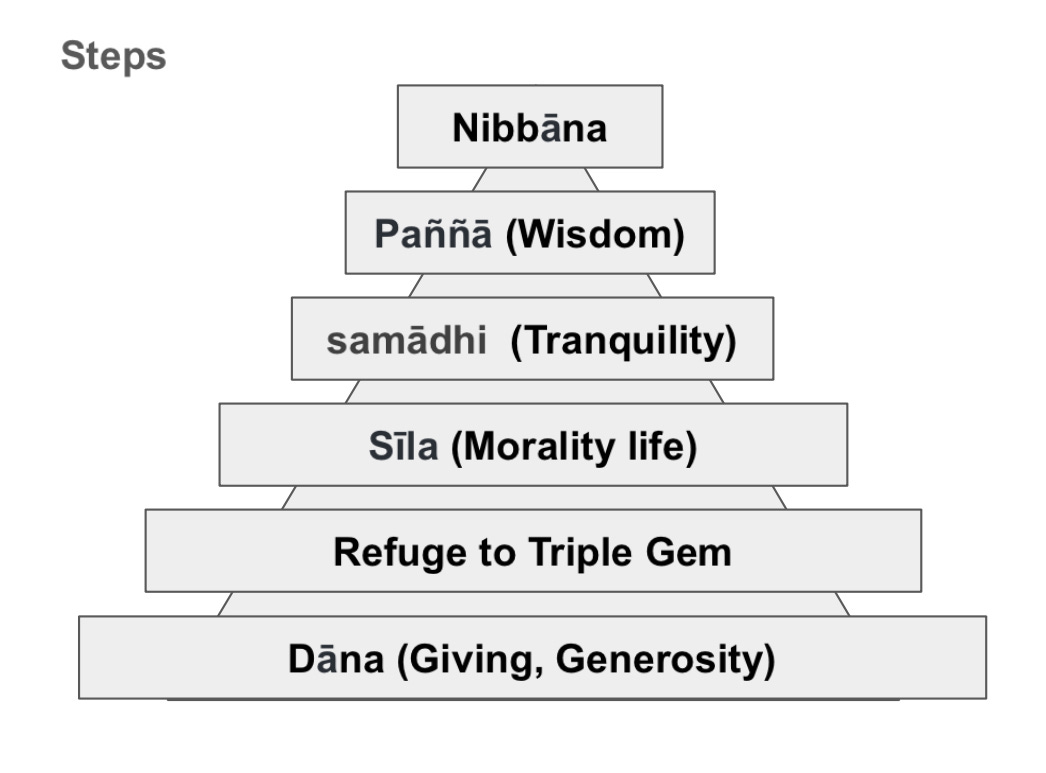Wisdom Insight Letter No. 184
Q&A 36 Nibbana (Nirvana) is not something that can be acquired or reached?
Q: Some say that nirvana is not something that can be acquired or reached. So, how is nirvana experienced?
A: Yes. That's right. Nibbana (Nirvana) is not simply achieved through hard work or reached at a certain point. Many Buddhist practitioners aim for and speak of nirvana. The word nirvana was already used in Indian philosophy and practice tradition before Gautama Buddha. So, the majority of practitioners still talk about and believe in such an ideological nirvana.
We first need to understand the definition of Nibbana explained by the Buddha. We must be able to see the Buddha's birth, his reflection on his life, his journey of practice, and his liberation up to enlightenment.
Samatha, which was already achieved in traditional Indian methods, was an idea of absolute tranquility through concentrated meditation, and it was recognized that pain would one day follow again. Afterwards, he sat on the Bodhi tree and observed the natural flow of breathing, and gained insight into the realities as they are. He gained insight into how human life can be liberated and completely free from the pain of birth, old age, illness, and death.
Buddha's enlightenment is the Four Noble Truths. He realized that the root of the mind that caused suffering was the concept of craving and aversion, and that the root was ignorance/delusion that did not know that fact.
Rather than a limited quiet state through concentrated meditation as in existing Indian practices, this is the work of completely revealing the roots of ignorance, that is, a pure mind that leaves behind all notions is continuously aware of the eternal ultimate state.
Nibbana, as defined by the Buddha, refers to an eternal and immortal state in which no uncleanness occurs beyond the three sufferings.
That state is not something that is simply achieved through hard work or reached at a certain point, but something that can be recognized through awareness.
However, since we are on the path of purity, there will be a destination where we will reach that point someday. The destination is Arahantship, a stage where one can never be reborn as anything else. There are stages in enlightenment, such as Sotāpanna (stream-enterer), Sakadāgāmi (once-returner), Anāgāmi (non-returner), and Arahant, so I don't think there will be any problem in expressing that sometimes one reaches the destination.
You can understand that the reason for taking issue with the use of words is to guard against the concept about nirvana, which leads to expectations or delusions of obtaining or achieving a certain result, and from making a futile conceptual approach.
The important thing is to understand whether you are trapped in an idea or follow in the pure flow of Dhamma. Identifying Paññatti (concept) and Paramaṭṭha (ultimate reality) is the key to insight into Nibbana. (Refer to previous insight letters: Understanding about Paññatti & Paramaṭṭha No. 123, No. 124, No. 125)
Thinking that Nibbana is good and trying to reach for it, that is delusion, too. -U Tejaniya Sayadaw.
May all practice well and reach to Magga (道, the path of enlightenment) and Phala (果, the fruit of enlightenment) in this very life!
with Metta,
Ayya Kosalla
at Brahma Vihara Meditation Center in California
Private Dhamma interview for any questions regarding meditation and personal difficulties.
Free E-book download: It is from all weekly letters since Oct 2020. May it help your practice with more understanding of Dhamma.
Ayya Kosalla Bhikkhuni guides Satipatthana meditation for Nibbana at ‘Brahma Vihara Meditation Center’ in Oakland, California. Those who need personal meditation guidance can receive valuable help: Dhamma Dāna.
Dāna is an opportunity to bring the practice of the Pāramī of Generosity into one's life, and to support the spread of Dhamma at this time. Dāna can be given and accepted gracefully and with heartfelt appreciation.
Zelle®: money travels directly between accounts with no stops in between. Send to ‘Brahma Vihara Foundation’.
-the recipient’s email address is brahmavihara.meditation@gmail.com
Make checks or money order payable to ‘Brahma Vihara Foundation’, and send to 6520 Heather Ridge Way, Oakland CA 94611
Venmo account ID: brahmavihara
Brahma Vihara Foundation (https://brahma-vihara.org/) is a religious non-profit corporation, recognized by the State of California. All donations are tax-deductible in the United States in accordance with IRS code section 501(c)(3) EIN: 93-3616062
If you have any questions related to dhamma & meditation, please feel free to ask. You can reach Ayya Kosalla directly at Bhikkhuni.Kosalla@gmail.com.
법에 대한 질문이 있으신 분은 위의 이메일 주소로 질문을 남겨주세요.
위빠사나명상의 마음관찰에 대한 논문을 한글 원본으로 읽고 싶으신 분은 클릭해서 다운로드 받을 수 있습니다. (네이버에 PDF 첨부)
The Korean Wisdom Insight Letter is here 지혜통찰편지.
Buddha Sāsanaṁ Ciraṁ Tiṭṭhatu!
May the Buddha’s teachings last a long time!
Bhavatu Sabba Sotiṁ ca Maṅgalaṁ ca!!
May everyone be led on the path of peace and blessing!!
Sādhu Sādhu Sādhu!






Sadhu 🙏🏼